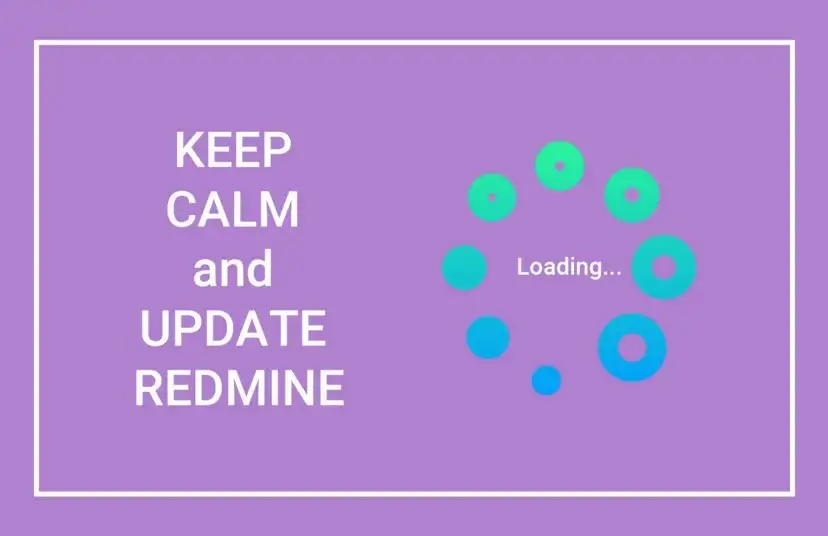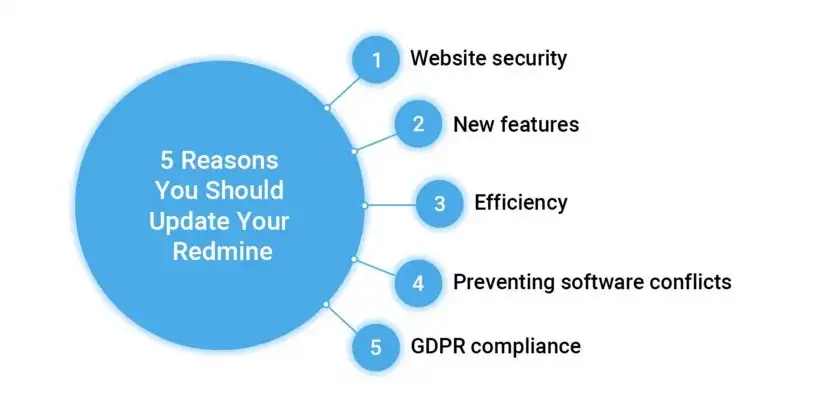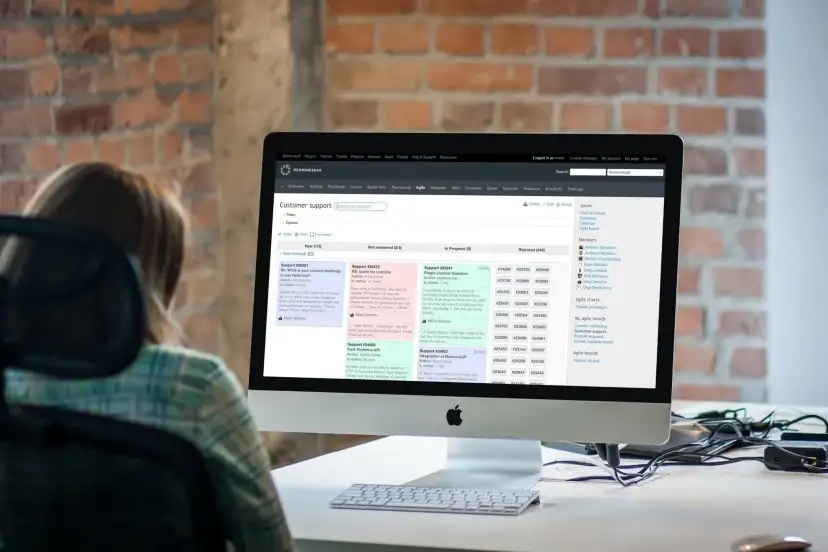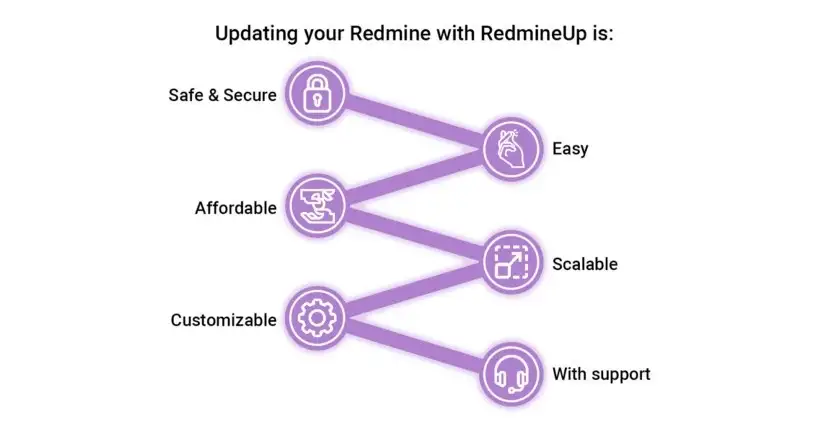
One universal takeaway from 2020 is that remote work is here to stay. As the world adjusts to the new normal of working from home as much as possible, CTOs and CIOs have to be a step ahead and unlock technology’s full potential to facilitate remote collaboration among decentralized teams.
Choosing the right software and hosting platform have become critical business decisions that can shape the outcome of your projects. As teams continue to work remotely, application availability, security, and business continuity planning are emphasized by CXOs more than ever.
In this article, we explore the reasons why you should keep your application updated, the risks associated with it, and how to get the best of both worlds, i.e. update your Redmine version while minimizing the risks and costs.
Redmine is a web-based project management app, and a great open-source alternative to other established (and licensed!) project management software.
Redmine’s native version is available for free, and businesses often use it to test the waters. However, for long-term use, we recommend getting the customized version because it’s more user-friendly and has a smoother learning curve, but it isn’t free.
To utilize Redmine’s full potential, your version must communicate well with other applications, databases, and APIs. As the saying goes, change is the only constant, and in the context of IT, this is especially significant.
Top 5 Reasons You Should Update Your Redmine
Redmine has features that can compete with some of the best project management tools in the industry. Nevertheless, choosing a software is only half the battle. You need to be on your toes when it comes to updating it without compromising on availability. At a bare minimum, you should meet the four nines (99.99% availability, which translates into less than 53 minutes of downtime annually) availability standard because your competition is likely doing it already.
Here are five compelling reasons to keep your Redmine updated:
- Data security — This is the top reason for updating any software, and Redmine is no different. While developers are fixing existing vulnerabilities, hackers are constantly finding new loopholes within systems. It is a cat and mouse game that goes on around the clock, and you do not want your systems to be exposed because you missed an update.
- New feature additions — Developers and usability experts work passionately to add new features and improve old ones. Besides making your systems more efficient and enhancing their capabilities, new features facilitate better communication with different applications.
- Efficiency — A connected software like Redmine is great for geographically dispersed teams. Instant data exchange is a key driver of a project’s success. As new communication protocols increase data transfer speeds, using an updated version of Redmine will give you the best performance and facilitate speedy collaboration.
- Preventing software conflicts — Even if you do not update your Redmine version, other software it interacts with may be updated, and you’ll experience a version conflict or receive an unsupported software message if you keep using the older version.
- GDPR compliance — Countries around the globe are getting serious about data protection. Data storage and processing regulations are changing all the time to make the laws watertight. This makes it critical to update your Redmine because you do not want to end up on the wrong side of the law by unintentionally violating GDPR norms.

Risks Associated With Updating Redmine
There are risks associated with any software application. Even Facebook, Google, and WhatsApp became inaccessible in the past because something didn’t work correctly.
When you update your Redmine version, you open yourself up to the following risks:
- Downtime — During the time your Redmine update is being installed, your system will be inaccessible. It won’t be up until your version is updated and re-launched. If things take a wrong turn, you’ll have unexpected downtime. While five nines (99.999% uptime, meaning an annual downtime of 5.26 minutes) is becoming increasingly common, aiming for four nines (99.99% uptime, i.e. 52.60 minutes of annual downtime) is a good start.
- Rails update — Redmine is built on Ruby on Rails. An update to Redmine requires you to have an updated version of Ruby on Rails as well, which multiplies your risk of downtime, data loss, and unexpected system behavior.
- Finding skilled professionals — Redmine is not the most user-friendly application, and updating it is more complicated than making of a few clicks. It requires a skilled, experienced professional. Depending upon the version and plan you are using, an update can take anywhere between a few hours to a few days. Experienced professionals usually charge by the hour, so you should set aside a budget for each update.
- Upgrading infrastructure — Applications come with a recommended hardware configuration, i.e. the minimum set of memory and processor requirements to run it. With time, these requirements increase, and before you know it, you need to upgrade your entire infrastructure in order to meet the minimum operating standards.
How Can I Update My Redmine While Minimizing Risks?
On one hand, you cannot keep using an outdated version of Redmine, and on the other, each update comes with its own share of risks. Although there are general hosting solutions ( Bitnami, AWS) providing regular updates, they only work with the generic version of Redmine and do not have customization and support. Is it a lose-lose situation? Is there a way to have the best of both worlds? Yes, there is.
There are some professional hosting providers covering customized versions of Redmine. If you are looking for an experienced provider that works with customizations and covers popular plug-ins with their updates, RedmineUP is here to ease your worries. Your infrastructure will be with professionals who have over 10 years of experience working with the installation and maintenance of Redmine. You’ll be able to harness the power of cloud computing without compromising on usability and support, keeping your systems updated with high uptime.

Cloud hosting your Redmine application offers many benefits:
Safe auto-upgrade — You’ll no longer face those agonisingly long downtimes. Your remotely hosted software will be upgraded in a matter of seconds, and all systems will be up before you know it! This guarantees an updated version at all times.
Easy maintenance — Since you don’t own your servers, you no longer need to hire IT specialists for its maintenance and support. Your Redmine application will be supported over the cloud for a fraction of the fee.
Cost optimization — Owning servers is a costly affair because you have to bear the operational costs whether or not you use them. Maintenance is another expensive overhead cost. Subscribing to cloud hosting solutions results in instant savings because you do not need physical space to store your Redmine servers.
Scalability — It is also a cost-optimization measure, but the flexibility offered by cloud-hosted Redmine benefits you in many other ways. If you are expecting a higher volume of work and adding more resources to your Redmine application, ask your cloud provider to make extra computing power available to you. Once the volume normalizes (or falls below normal), you can scale down your infrastructure accordingly. Besides being a cost-saver, this keeps your system running at all times.
SAML authentication — This innovative technology allows the user to access all external systems integrated with Redmine by entering their credentials only once. The system authenticates the user and then shares the information with the integrated systems. It saves time, decreases the chance of losing access, and reduces costs for service providers.
Customization — Your hosting provider will customize Redmine according to your requirements. You have more variants to choose from at a lesser investment compared to a self-hosted Redmine platform. It can be integrated seamlessly with your internal time-tracking tools and also provide a customized domain, if required. You have many useful plug-ins to choose from to integrate your CRM, help desk, Agile projects, and much more.
Easy access — A cloud-hosted Redmine solution is accessible around the clock. You do not need to worry about maintaining a constant power supply and keep a back-up handy in case of power failures. You can monitor your projects through mobile devices as well, so you are always connected to your project. All you need is a computer connected to the internet, and Redmine will be available at your fingertips!
Security — Cloud hosting providers are professionals who adhere to the highest level of security standards and provide security certificates such as ISO/IEC 27001:2013. Among the specific security options are data encryption with TLS\SSL, daily backups from two separate services, Application Load Balancer, and Kubernetes cluster management. Regular security patches and updates provide real-time, around-the-clock security to your Redmine package.
Support — Redmine is a free platform and does not provide dedicated support. Yes, you can reach out to its community and search or ask for solutions, but it is time-consuming and does not always guarantee a speedy, accurate resolution. A dedicated support team can track your issues and generate weekly dashboards so that you can track your KPIs closely. It can also speed up ticket resolution and set up an industry standard practice such as Scrum/Kanban to make the process more efficient.
Affordable — Pay as you go! You don’t need to spend money on IT infrastructure and hire developers. Just start with the cloud, and everything is ready for work.
All these benefits would not be useful if it drove the cost exceptionally high, right? If you use Redmine and do not want to spend time and resources on maintaining it, we highly recommend experienced professionals . Using their expertise, they will analyze your requirements and provide a customized solution for your software maintenance at an affordable cost while you focus on your core projects.

If any of reasons shared above resonate with you, take a first step and try RedmineUP Cloud for 15-days free.
Summary
Keeping your Redmine version up-to-date is highly-recommended. However, it comes with its share of risks. If you are looking for a reliable, secure, and efficient way of using the latest version of Redmine while negating risks, the RedmineUP cloud-hosted solution is the way to go.

